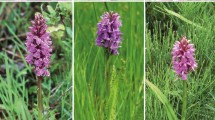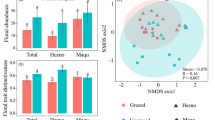Abstract
Dioecious plant populations are composed of two distinct sexual morphs representing the female and male counterparts. Dioecy in restinga areas has been strongly associated with fleshy fruits, woodiness, generalist entomophily, and resource-poor environments. The ability of vegetative reproduction is another ecological trait commonly associated with dioecy, but not shown for the woody dioecious species in restingas. This study aimed to investigate whether the distribution of sexual morphs in populations is due to occurrence of vegetative propagation as a reproductive strategy among dioecious woody species on sandy coastal plains. We also intended to evaluate possible effects of sex ratio on sexual reproduction (female reproductive success). The study was conducted in the sandy coastal plains (restinga) of Maricá, Rio de Janeiro State. We studied six woody dioecious species. During the reproductive period, all individuals of each species and your nearest neighbor were marked using GPS, along an area with approximately 5.1 ha. The sex of the individuals was recorded. This study provides evidence of the occurrence of vegetative propagation in the woody dioecious species studied and indicates that the ability to reproduce in this manner varies between sexual morphs, generating male-biased populations in most cases. Our data suggest that asexual reproduction by vegetative propagation of the male morphs can have an effect on sexual reproduction, as it increases the amount of staminate flowers, and therefore the supply of the pollen grains. Our results provide insights into vegetative reproduction as a strategy to increase male plant fitness and an alternative to populate environments under stress.



Similar content being viewed by others
References
Abrahamson WG (1980) Demography and vegetative reproduction. In: Solbrig OT (ed) Demography and evolution in plant populations. Blackwell, Oxford, pp 89–106
Ågren J (1988) Sexual differences in biomass and nutrient allocation in the dioecious Rubus chamaemorus. Ecology 69:962–973
Albuquerque AA, Lima HA, Gonçalves-Esteves V, Benevides CR, Rodarte ATA (2013) Myrsine parvifolia (Primulaceae) in sandy coastal plains marginal to Atlantic rainforest: a case of pollination by wind or by both wind and insects? Braz J Bot 36:65–73
Amorim W, Oliveira PE (2006) Estrutura sexual e ecologia reprodutiva de Amaioua guianensis Aubl. (Rubiaceae), uma espécie dioica de formações florestais de cerrado. Rev Bras Bot 29:353–362
Amorim FW, Mendes-Rodrigues C, Maruyama PK, Oliveira PE (2011) Sexual ratio and floral biology of the dioecious Neea theifera Oerst. (Nyctaginaceae) in a cerrado rupestre of central Brazil. Acta Bot Bras 25:785–792
Araújo DSD (1984) Análise florística das restingas do Estado do Rio de Janeiro. In: Lacerda LD, Araújo DSD, Cerqueira R, Turcq B (eds) Restingas: origem, estrutura, processos. Universidade Federal Fluminense/CEUFF, Niterói, pp 159–193
Bierzychudek P, Eckhart V (1988) Spatial segregation of the sexes of dioecious plants. Am Nat 132:34–43
Cirne P, Scarano FR (2001) Resprouting and growth dynamics after fire of the clonal shrub Andira legalis (Leguminosae) in a sandy coastal plain in southeastern. Brazil J Ecol 89:351–357
Cox PA (1981) Niche partitioning between sexes of dioecious plants. Am Nat 117:295–307
Faria APG, Matallana G, Wendt T, Scarano FR (2006) Low fruit set in the abundant dioecious tree Clusia hilariana (Clusiaceae) in a Brazilian restinga. Flora 201:606–611
Janzen DH (1977) A note on optimal mate selection by plants. Am Nat 111:365–371
Lenza E, Oliveira PE (2005) Biologia reprodutiva de Tapirira guianensis Aubl. (Anacardiaceae), uma espécie dioica em mata de galeria do Triãngulo Mineiro, Brasil. Rev Bras Bot 28:179–190
Lenzi M, Orth AI (2012) Fenologia reprodutiva, morfologia e biologia floral de Schinus terebinthifolius Raddi (Anacardiaceae), em restinga da Ilha de Santa Catarina, Brasil. Biotemas 17:67–89
Lloyd DG (1974) Theorical sex ratios of dioecious and gynodioecious angiosperms. Heredity 32:11–34
Lloyd DG, Webb CJ (1977) Secondary sex characters in plants. Bot Rev 43:177–216
Matallana G, Wendt T, Araújo DSD, Scarano FR (2005) High abundance of dioecious plants in a tropical coastal vegetation. Am J Bot 92:1513–1519
Maun MA (1994) Adaptations enhancing survival and establishment of seedlings on coastal dune systems. Vegetatio 111:59–70
Morellato LPC (2004) Phenology, sex ratio and spatial distribution among dioecious species of Trichilia (Meliaceae). Plant Biol 6:491–497
Nicotra AB (1998) Sex ratio variation and spatial distribution of Siparuna grandiflora, a tropical dioecious shrub. Oecologia 115:102–113
Obeso JR (2002) The costs of reproduction in plants. New Phytol 155:321–348
Opler PA, Bawa KS (1978) Sex ratios in tropical forest trees. Evolution 32:812–821
Ormond WT, Pinheiro MCB, Lima HA, Correia MCR, Castro AC (1991) Sexualidade das plantas da restinga de Maricá, RJ. Boletim do Museu Nacional, (N. S. Botânica) 87:1–24
Perrin P (1984) Evolução da costa fluminense entre as Pontas de Itacoatiara e Negra: Preenchimento e restinga. In: Lacerda LD, Araújo DSD, Cerqueira R, Turcq B (eds) Restingas: origem, estrutura, processos. Universidade Federal Fluminense/CEUFF, Niterói, pp 65–74
Pielou EC (1977) Mathematical ecology. Wiley, New York
Queenborough SA, Burslem DFRP, Garwood NC, Valencia R (2007) Determinants of biased sex ratios and inter-sex costs of reproduction in dioecious tropical forest trres. Am J Bot 94:67–78
R Development Core Team (2014) A language and environment for statistical computing. R Foundation for Statistical Computing, Vienna. http://www.R-project.org/
Rizzini CT (1979) Tratado de Fitogeografia do Brasil. Aspectos ecológicos, vol 2. HUICITEC/EDUSP, São Paulo
Rodarte ATA (2008) Caracterização espacial, temporal e biologia floral das espécies de restinga, com ênfase nos recursos florais. Ph.D. thesis, Universidade Federal do Rio de Janeiro/Museu Nacional, Rio de Janeiro
Sampaio MC, Pico FX, Scarano FR (2005) Ramet demography of a nurse bromeliad in Brazilian restingas. Am J Bot 92:674–681
Sanchez-Vilas J, Pannell JR (2010) Differential niche modification by males and females of a dioecious herb: extending the Jack Sprat effect. J Evol Biol 23:2262–2266
Scarano FR (2002) Structure, function and floristic relationships of plant communities in stressful habitats marginal to the Brazilian Atlantic rain forest. Ann Bot 90:517–524
Scarano FR (2009) Plant communities at the periphery of the Atlantic rain forest: rare-species bias and its risks for conservation. Biol Cons 142:1201–1208
Sinclair JP, Emlen E, Freeman DC (2012) Biased sex ratios in plants: theory and trends. Bot Rev 78:63–86
Thomas SC (1997) Geographic parthenogenesis in a tropical forest tree. Am J Bot 84:1012–1015
Thomas SC, La Frankie JV (1993) Sex, size, and interyear variation in flowering among dioecious trees of the Malayan rain forest. Ecology 74:1529–1537
Vieira S (1981) Introdução à bioestatística. Campus Ltda, Rio de Janeiro
Wheelwright TN, Bruneau A (1992) Population sex ratios and special distribution of Ocotea tenera (Lauraceae) trees in a tropical forest. J Ecol 80:425–432
Zaluar HLT, Scarano FR (2000) Facilitação em restinga de moitas: um século de buscas em espécies focais. In: Esteves FA, Lacerda LD (eds) Ecologia de restingas e lagoas costeiras. UFRJ, Rio de Janeiro, pp 3–23
Zamith LR, Scarano FR (2004) Produção de mudas de espécies das restingas do município do Rio de Janeiro, RJ, Brasil. Acta Bot Bras 18:161–176
Zar JH (1999) Bioestatistical analysis. Prentice-Hall, New Jersey
Acknowledgments
The authors thank the anonymous reviewers for their helpful comments; Dr. Rita de Cássia Ribeiro Gama and the biologist Marina Muniz Moreira for helpful comments on the manuscript text. This study is part of the Ph.D. thesis of C.R.B. which was carried out in the Postgraduate Program in Biological Sciences (Botany) of the Universidade Federal do Rio de Janeiro (UFRJ), Museu Nacional, Rio de Janeiro, Brazil, and was supported by CAPES (Coordenação de Aperfeiçoamento de Pessoal de Nível Superior). This manuscript was written during a hands-on Workshop done by Publicase and reviewed by a professional science editor and by a native copy-editor to improve readability.
Author information
Authors and Affiliations
Corresponding author
Rights and permissions
About this article
Cite this article
Benevides, C.R., Rodarte, A.T.A. & de Lima, H.A. Vegetative propagation as a successful reproductive strategy in woody dioecious species in tropical coastal vegetation, southeast Brazil. Braz. J. Bot 38, 579–584 (2015). https://doi.org/10.1007/s40415-015-0162-x
Received:
Accepted:
Published:
Issue Date:
DOI: https://doi.org/10.1007/s40415-015-0162-x




